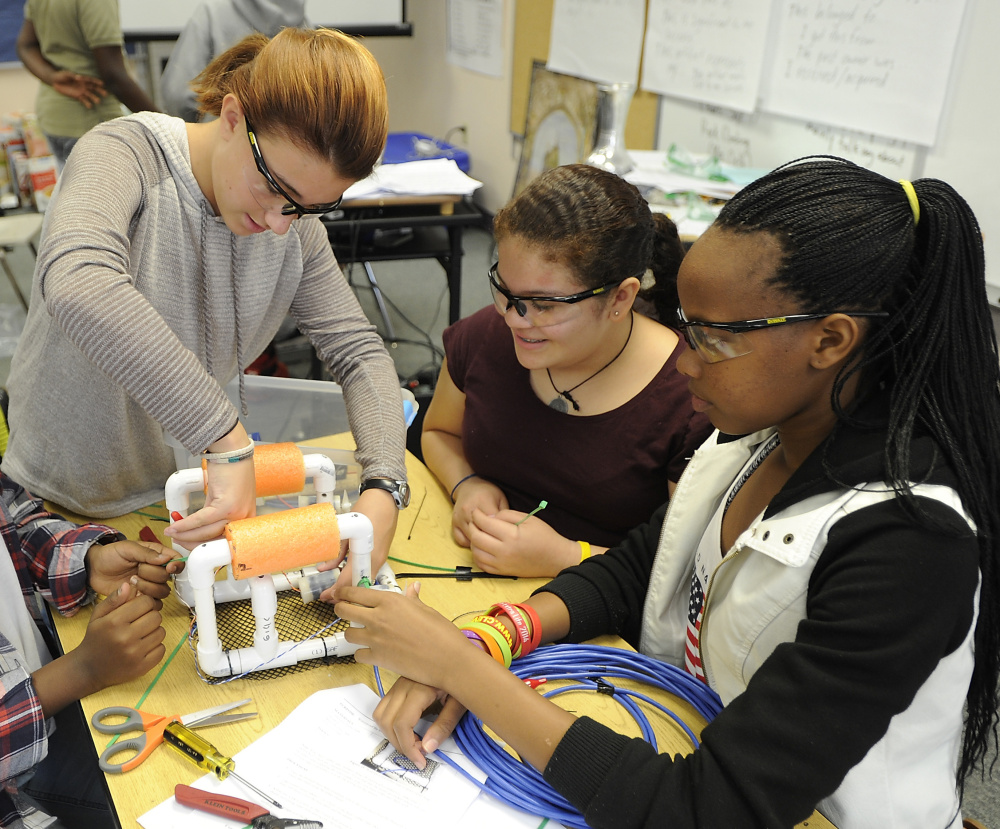Josh Willey, 13, knows how gross it is to go swimming in a lake that’s got thick weeds and a bunch of gunk on the bottom.
He’s keeping that image in mind as he and his seventh-grade classmates at King Middle School tackle their fall semester “expeditionary” learning project: building remote-operated underwater vehicles that will be used by the state to fight invasive species in Maine’s lakes.
“This is really a big deal,” Willey said. “It’s really helping out the environment and our lakes, and it’s a fun task.”
This is just the latest project at King that has to do with sustainability, and an example of the sophisticated hands-on environmental learning that is becoming more common in schools.
Under King’s expeditionary learning model, students undertake eight- to 12-week “expeditions” revolving around a core theme. Other expeditions have had students studying the health of the Fore River ecosystem, creating devices to capture wind and solar power, studying the role of plankton in the health of the Gulf of Maine and explaining how bacterium contribute to soil health.
The 35 submersibles being built at King this fall will be used by the Maine Department of Environmental Protection to locate and identify aquatic invasive plants like milfoil. Unchecked, those species can overrun native plants, upset natural ecosystems and choke otherwise clear lakes.
The project is the central focus of all their coursework this semester, including reading, writing, math and social science. Building the devices teaches them engineering concepts, not to mention self-confidence and problem-solving skills.
Those are the skills tomorrow’s leaders will need to solve daunting environmental challenges, one instructor said.
“There’s a fearlessness that comes from doing this kind of project,” said instructor Bobby Shaddox, as he watched students put the finishing touches on their submersibles. “This project leads you to believe you can figure something out.”
The “Sea Perch” submersibles are put together using a kit developed by the Massachusetts Institute of Technology. Students get a large plastic bag filled with a concoction of PVC pipe, flotation material, three propellers, some netting, zip ties, a sealed 12-volt battery and a long cable that will allow an operator in a boat to direct the device.
In their third day of building the submersibles, King students who perhaps had never handled any tools before were deftly twisting off ties with needle-nose pliers, using soldering irons to make connections, using drills to put together the devices, and attaching motors to frames.
The students were abuzz with not only how to assemble the devices, but how they will be used. The students could attach waterproof cameras to the devices, claws to grab plants or a basket to collect samples.
Willey said he could see how the invasive species project is connected to bigger issues of a greener world.
His grandmother, he said, has told him stories about how people never used to worry about recycling or throwing glass out in the streets or woods, which he described as “all that bad stuff.”
Today, he and his family volunteer their time to cleanup efforts and recycling projects: “We want to keep our environment clean.”
Tomorrow’s problems are about more than sorting out aluminum cans, he said.
“We know we’re going to get invasive plants,” Willey said. “In the end, if we do nothing, when we go swimming everyone will be coming out covered with seaweed.”
Audrey Watson, 11, said she likes that her schoolwork fits in with her larger concerns about recycling and being “green” and actively working toward a sustainable future.
“I think the world would be so much better if everyone would just take five minutes and clean up or pick up or recycle,” Watson said.
Copy the Story LinkSend questions/comments to the editors.




Success. Please wait for the page to reload. If the page does not reload within 5 seconds, please refresh the page.
Enter your email and password to access comments.
Hi, to comment on stories you must . This profile is in addition to your subscription and website login.
Already have a commenting profile? .
Invalid username/password.
Please check your email to confirm and complete your registration.
Only subscribers are eligible to post comments. Please subscribe or login first for digital access. Here’s why.
Use the form below to reset your password. When you've submitted your account email, we will send an email with a reset code.